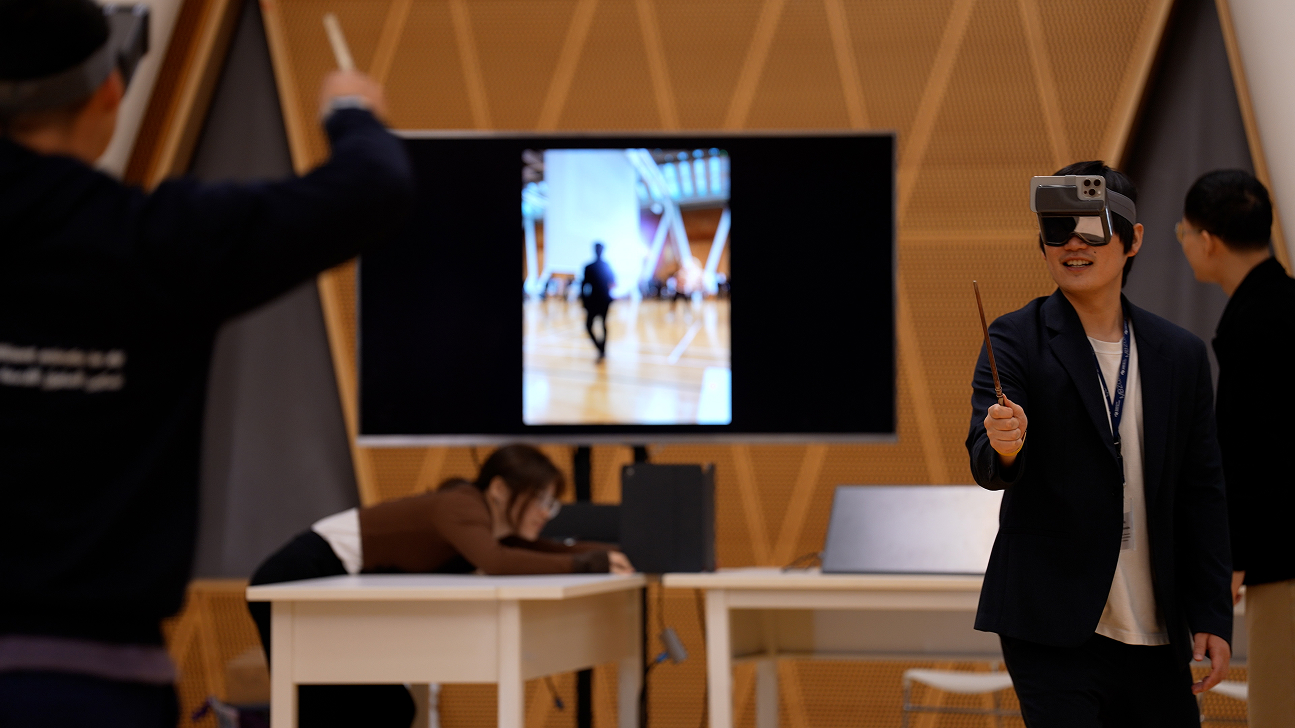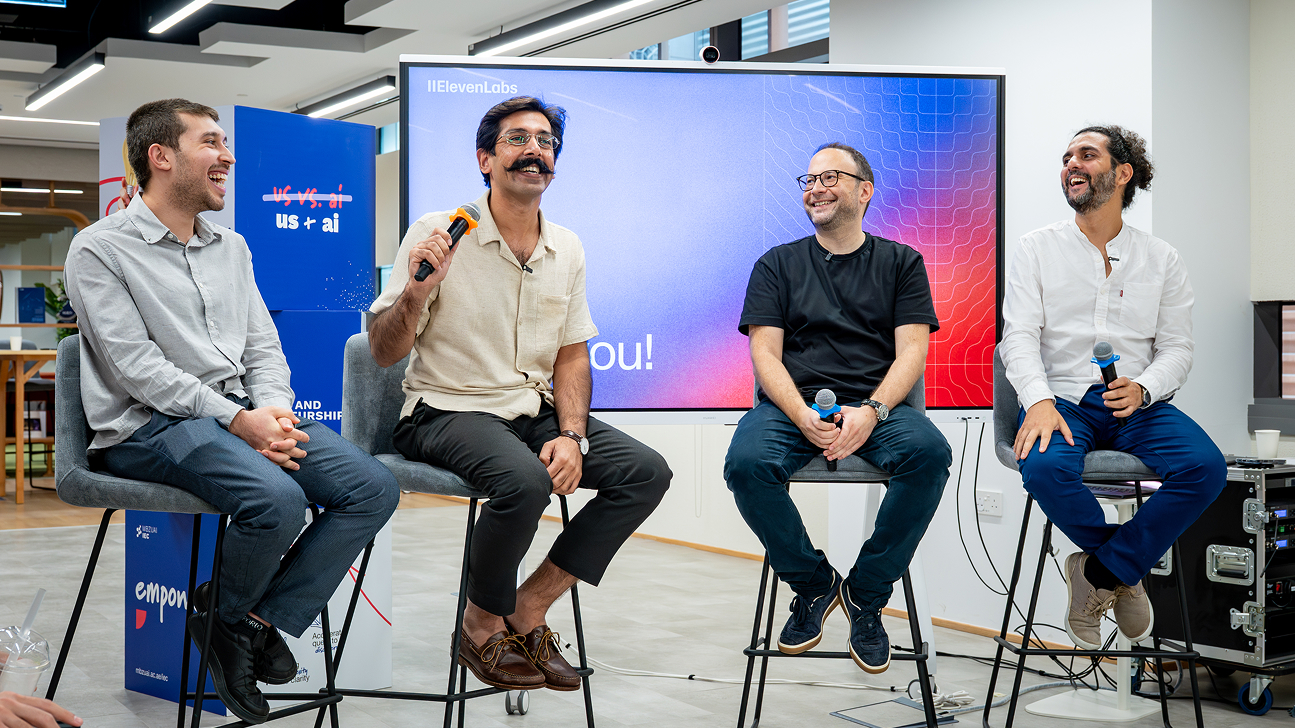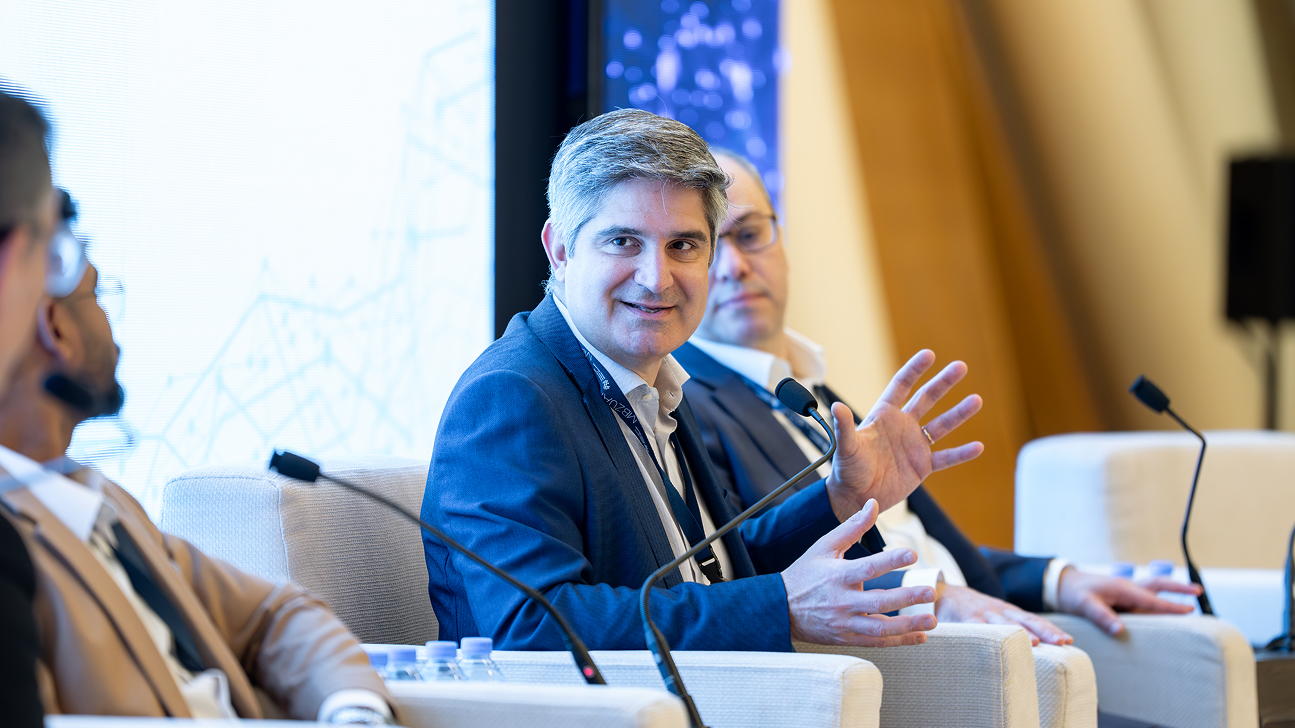Augmented Humans 2025: Advancing Human Potential at MBZUAI
Tuesday, March 25, 2025

Technology’s role in enabling the next stage of human ability was the focal point for a series of talks, presentations, workshops and demonstrations at MBZUAI, as the Augmented Humans International Conference 2025 (AHs) arrived in the Middle East for the first time.
AHs took place at the University’s Masdar City campus from 16-20 March in cooperation with the Association for Computing Machinery (ACM), attracting more than 180 leading researchers and enthusiasts to discuss the present and future of human augmentation.
“The Augmented Humans conference looks at how any kind of technology can improve our decision making, compensate for physical injuries, communicate better, perform at a higher level, become more efficient, and remove burdens and barriers that might be holding us back,” said Elizabeth Churchill, Department Chair and Professor of Human-Computer Interaction (HCI) at MBZUAI.
“During the five days, we talked about innovations from AI-enhanced storytelling experiences to AI-enhanced prosthetics for people who have suffered injuries, and everything in between. But it wasn’t just about design and prototypes; we also focused on evaluating how effective these technologies will be – a key aspect of the conference.”
Churchill played a leading role in bringing AHs to the University, acting as sponsor and local host after working with the steering committee to bring it to Abu Dhabi.
“We were delighted to host AHs at MBZUAI because we feel that many of the ideas that are being generated in the augmented humans community are not only coming into realization but are being amplified by innovations in AI,” she added.
 Elizabeth Churchill, Department Chair and Professor of Human-Computer Interaction (HCI) at MBZUAI.
Elizabeth Churchill, Department Chair and Professor of Human-Computer Interaction (HCI) at MBZUAI.
Enhancing human capability
The AHs conference is an international annual event, and has been held in Japan, Germany, Singapore, Switzerland, USA, UK, Finland, Australia, and the Republic of Korea – and now in the UAE.
This year’s program featured a diverse range of talks across eight sessions that included: AR/VR Interaction and Physical Augmentation, Virtual Reality and Human Experience Enhancement, Bionic and Assistive Systems, Robotics and Avatars, Decision-Making and Human Behavior, Exploring Body-Augmentation, Cognitive and Perceptual Augmentation with AI, and Sensory Technologies.
The conference also showcased 32 papers, 21 posters, seven demonstrations, and two workshops entitled ‘Secured Augmentation: On-Body Security and Safety Interfaces’, and ‘Beyond Human: Cognitive and Physical Augmentation through AI, Robotics and XR – Opportunities and Risks’.
The Best Paper award was presented to authors Ritik Batra, Narjes Pourjafarian, Samantha Chang, Margaret Tsai, Jacob Revelo and Cindy Hsin-Liu, for their paper “texTENG: Fabricating Wearable Textile-Based Triboelectric Nanogenerators”.
“The 2025 edition of AHs has made history by setting multiple records, establishing itself as one of the most significant milestones in the conference’s history,” said Yomna Abdelrahman, Post-Doctoral Researcher at the Armed Forces University in Munich, Germany, and one of the three General Chairs of AHs 2025.
“As the longest-running AHs event to date, spanning five days, AHs 2025 is also the largest-ever gathering, with 186 registrants. More importantly, this is the first edition to be held in the MENA region. We are proud to have reached such remarkable milestones, and to have provided a platform for international and local audiences to engage with world-class experts, facilitating meaningful collaborations and knowledge sharing.”
 Several demonstrations took place during AHs 2025, including this soft manipulator that can handle delicate objects.
Several demonstrations took place during AHs 2025, including this soft manipulator that can handle delicate objects.
Bridging innovation with inclusivity
Visiting attendees also took the opportunity to explore collaboration opportunities and engage with the local community, ensuring their involvement in shaping the future of human augmentation.
“This edition aimed to foster engagement with the local research community, introduce the field of human augmentation, explore its transformative potential and offer a call to bridge innovation with inclusivity,” said Andrew Vargo, Research Associate Professor at Osaka Metropolitan University and another of the conference’s General Chairs.
And as a leading university dedicated to AI, MBZUAI was the ideal place to host this year’s conference, argues Anusha Withana, Associate Professor in HCI in the School of Computer Science at the University of Sydney, and also General Chair.
“MBZUAI’s forward-thinking vision and rapid growth align perfectly with AHs’ evolution,” he said. “With its recently launched HCI department, cutting-edge research and a thriving academic environment, MBZUAI provides an ideal environment to showcase the advances made in human augmentation.”
The wider picture
One of the main goals of AHs, explained Vargo, is to get promising augmentation technologies out of the lab and into real-world situations.
“This is a difficult task,” he said. “For instance, there are many wonderful technologies that can assist with learning that never are made accessible to users. Our hope is that as the community grows and shares, collaboration and communication will help fix this.”
Churchill added that while there has been a long-term agenda around augmentation, it’s only now, with the rapid development of AI, that many ideas can be implemented.
“People have had big design ideas about “intelligent” augmentation. Most of these have been visionary prototypes, until now. We are at a moment where we can use AI techniques to bring ideas to fruition, using AI techniques in the small and at scale, to have an impact on individuals, groups, and communities. These can add up to societal level impact.”
Withana agrees, adding: “Advances in AI, robotics, and biotechnology allow for enhanced physical and cognitive abilities, from bionic limbs to brain-computer interfaces. These innovations are revolutionizing industries, healthcare, and daily life, pushing the boundaries of human potential and redefining what it means to be capable.”
While this recent change in applicability comes with great excitement and potential for innovation, the use of AI should also be approached with some caution, said Churchill.
“Now we can actually start to implement some of our ideas, some questions remain: What do we want to implement? Just because we can implement something, should we? What is the AI that’s underneath, and how transparent, explainable and modifiable is it? This is an ethical and values-related judgment space that will always be part of the discussion at AHs.
“At MBZUAI we’re committed to thinking about this bigger picture, delivering not just the technology, but also the guidelines for what are the right investments versus what are the investments that are potentially harmful to humans.
“This is one of the reasons the University has invested in a Human-Computer Interaction department — to ensure that everything we think about at MBZUAI is about how we take all the best things around being human and push forward and improve.”
With these considerations being integrated into conversations about breakthrough technologies and innovative research, AHs offers a holistic and forward-thinking forum focused on beneficial and safe outcomes from a coherent agenda around intelligent human augmentation.
- innovation ,
- robotics ,
- conference ,
- Human–computer interaction ,
- campus ,
- HCI ,
- Augmented Humans ,
- AHs ,
- ACM ,
- augmentation ,
Related
MBZUAI and Abu Dhabi Music & Arts Foundation explore AI's Impact on the Arts at 4th Mailis
The event was part of ADMAF’s Riwaq Al Fikr initiative – a dedicated series of talks and.....
- collaboration ,
- Mailis ,
- creativity ,
- art ,
- music ,
- culture ,
- HCI ,
- partnership ,
The future of audio AI: adoption use cases powering the Middle East
Voice AI is fast becoming the default interface. ElevenLabs joined MBZUAI to explore its impact across industries.....
- voice ,
- audio ,
- incubation and entrepreneurship center ,
- agents ,
- IEC ,
- entrepreneurship ,
- innovation ,
- startup ,
The future of robotics, rooted in Italian ingenuity
Raised amid Tuscany’s long tradition of engineering excellence, Cesare Stefanini is carrying the same creative spirit into.....
- healthcare ,
- innovation ,
- industry ,
- robotics ,
- faculty ,
- biorobotics ,


